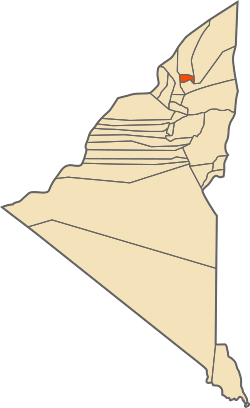Ouled Said
Ouled Said | |
|---|---|
 | |
| Country | |
| Province | Adrar |
| Time zone | UTC+1 (West Africa Time) |
Ouled Said (Arabic: أولاد سعيد) is a town in the central region of Algeria, specifically located within Adrar Province. Established as a municipality in 1985, Ouled Said was formed following its separation from the municipality of Timimoun. The town has experienced consistent demographic growth, as reflected in population statistics from various census years: 1977 (4,990), 1987 (5,898), 1998 (7,538), and 2008 (8,223). The upward trend in population concentration in the municipality remained below the provincial average of Adrar, which was recorded at 92.6% in 2008.
Geography and Demographics
Ouled Said comprises approximately ten scattered villages within an oasis setting. According to local data, the municipality includes 14 villages, such as Ouled Said, Hadj Guelmane, Kali, and others. Each village consists of small farms, with agricultural lands divided among residents.
In terms of agriculture, Ouled Said boasts about 130 hectares of arable land, with 90 hectares being irrigated. The town is home to over 26,400 date palms, showcasing a significant agricultural presence. Despite this, more than a third of the arable land remains uncultivated, attributed to various social and economic factors, including a lack of qualified farmers.
Historical Context
The area of Ouled Said has a rich historical background, characterized by changes in administration and societal structures. The establishment of the municipality in 1985 marked a turning point in local governance and infrastructure development, leading to the construction of essential facilities such as a municipal office, schools, and healthcare centers.
During the colonial period, inhabitants faced extreme poverty, leading to a cycle of migration in search of better opportunities, particularly in urban areas and oil-rich regions. The establishment of transportation routes further facilitated this migration.
Socio-Economic Changes
The introduction of the Agricultural Revolution Law in 1971 significantly altered social structures, theoretically liberating certain social classes while failing to implement land nationalization effectively. This resulted in tensions among landowners and laborers, impacting agricultural productivity.
In the 1990s, improvements in relations between local leaders and the central government led to initiatives aimed at revitalizing local agriculture and restoring traditional irrigation systems. Programs aimed at enhancing agricultural practices and infrastructure have been implemented since the early 2000s.
Cultural Significance
Culturally, Ouled Said is known for maintaining its traditional practices and communal identity. The social fabric is influenced by local religious groups and traditional ceremonies, which continue to play a vital role in community life.
References
• Center of Research in Social and Cultural Anthropology, Algeria
• Bellil, R.-A. (2000). Les oasis du Gourara (Sahara algérien) II fondation des ksour. Paris-Louvain : Éditions Peeters, p. 276.
• Bellil, R.-B. (2000). Les Zénètes du Gourara, leurs saints et l’ahellil. Insaniyat, (11), Oran : CRASC.
• Bendjelid, A. Brûlé, J.-C. & Fontaine, J. (dir.), Aménageurs et aménagés en Algérie. Héritages de années Boumediene et Chadli. Paris : L’Harmattan, ISBN : 2-7475-7.
• Bendjelid, A. & al. (1998). Mutations sociales et adaptation d’une paysannerie ksourienne du Touat : Ouled-Hadj-Maamoun (wilaya d’Adrar, Algérie). Insaniyat, (7), Oran : CRASC.
• Bisson, J. (2003). Mythes et réalités d’un désert convoité : le Sahara. Paris : L’Harmattan, p. 480
• Bisson, J. (1957). Le Gourara. Étude de géographie humaine. Alger : Institut de recherches sahariennes, p. 221
• Bisson, J. (1987). Paysans et nomades aux confins de l’Erg occidental : les raisons d’une permanence de la vie rurale. Actes du Colloque d’Adrar, Perspectives de l’agriculture saharienne, Oran : URASC.
• Commune d’Ouled Saïd, Services techniques, 2003, 2005 et 2010.
• Marouf, N. (2010). L’eau, la terre, les hommes. Passé et présents des oasis occidentales (Algérie). Paris : L’Harmattan, deuxième édition augmentée avec DVD inclus, p. 280.
• Marouf, N. (1980). Lecture de l’espace oasien. Paris : Sindbad, p. 281.
• Meghoufi, A. & Bentbelkacem, K. (2002). Eau et espace agricole dans l’oasis d’Ouled-Saïd (Gourara, Algérie). Mémoire d’ingénieur, aménagement rural, Université d’Oran, p. 81.
• Ministère de l’aménagement du territoire et de l’environnement (s.d.), Aménager l’Algérie de 2020, Alger, p. 182
• Moro, A. & Kalaora, B. (dir.), (2005). Le désert, de l’écologie du divin au développement durable. Paris : L’Harmattan, p. 265.
• Office national des statistiques, (2002). Évolution des agglomérations 1987-1998, Alger.
• Office national des statistiques, Principaux résultats de l’exploitation exhaustive. Wilaya d’Adrar, Revue Données statistiques, (527/01), p. 32, Alger, 2010.
• Otmane, T. (2010). Mise en valeur agricole et dynamiques rurales dans le Touat, Gourara et Tidikelt (Sahara algérien). Thèse de doctorat en cotutelle en géographie et aménagement du territoire, Université d’Oran, p. 399.
• Subdivision des services agricoles et Subdivision de l’hydraulique, Timimoun.
• Tabbouch, A. (2011). Les villages socialistes pastoraux frontaliers en milieu steppique : le cas de la Wilaya de Naama (Algérie). Mémoire de magister, en géographie et aménagement du territoire, Université d’Oran, p. 144.
• Yalaoui, A. (2008). La crise de reproduction de la société traditionnelle en Algérie. Thése de Doctorat d’État, sociologie, Université d’Oran, p. 375.

